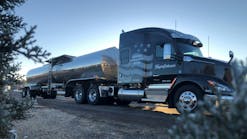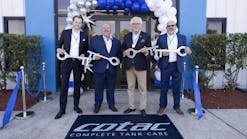New Houston-area wash rack, tank container depot, tank truck fleet terminal brings more business opportunities for Slay Transportation Company.
STARTING the project from a 20 acre green-field site in February of 2014 the development process began with acquiring the required permits to build the terminal facility. The terminal was completed and initiated its start up in March of 2016.
Now less than a year after opening its doors the Slay Transportation terminal in Baytown, Texas, is every bit as busy as the tank truck carrier’s other two Houston-area terminals.
The focal point of the new terminal is a state of the art fully automated six-bay tank wash that is among the most advanced in technology and environmentally friendly. It is an impressive facility with room for growth.
Managers direct tank cleaning operations from a central computerized control center, and the facility currently cleans about 20 to 30 chemical tank trailers and tank containers a day.
Also part of the Baytown terminal complex is a 20,000-sq-ft building that is now home to Slay Transportation’s Houston-based liquid and dry bulk trucking operations. Dispatchers manage over 100 drivers that are assigned to the facility for tank trailer and intermodal businesses. Resources at the terminal include 120 chemical tank trailers and 45 tank container chassis with lift kits for transporting single and double tanks.
The new terminal has a full-service tank container maintenance building for customer prep and repairs in the 12,000-sq-ft shop area. There is enough staging area to accommodate upwards of 800 tank containers on site with two light lifts to manage inbounds and outbound requirements. Current through-put volume is approximately 800 to 1,000 tank containers each month with space and capacity to grow.
Growth strategy
“Building this new facility was a critical part of our continued expansion and long term growth strategy,” says Gary Slay, CEO of Slay Industries. “Slay now offers our customers a third 20-acre multi modal service facility for our customers in the greater Houston area.
“We see a lot of growth opportunity in the Houston area. We consider the Port of Houston to be a pro-business. We also believe the Port of Houston will become the biggest port in the United States over the next few years”.
The 20-acre Slay Transportation terminal in Baytown is every bit as busy as the tank truck carrier’s other two Houston-area terminals.
“All three of our Houston-area locations are getting busier, and that is good news,” Slay says. “Our bulk chemical, Intermodal and packaging and drumming business has been trending positive the past couple of years. We have seen a 10% to 15% increase in activity in the first quarter of 2017.
“We have experienced an increase in tank trailer and intermodal shipments from Houston to points in the United States, Canada, and Mexico. We are hiring more drivers to keep up with the demand.”
While Houston has become a focal point for Slay Transportation, the carrier is still headquartered in St Louis, Missouri. In all, the carrier runs roughly 425 tractors and just over 1,000 trailers—tanks, vans, and container chassis.
Average trip length is 800 miles, and the carrier provides local, regional, and longhaul service. “Our regional hauls typically are in the 300-mile range and most are out and back,” Slay says. “We do a lot of dedicated work.”
First terminal
Slay Transportation opened its first Houston-area terminal in Jacinto Port along the Houston Ship Channel in 1992. In addition to the three-bay tank wash rack, the facility has a 5,000-ft rail siding for transloading and a 200,000-sq-ft warehouse that handles product in drums, bags, and super sacks.
Trucking operations at the Jacinto Port location include transloading to and from railcars and local and regional liquid bulk transportation. Dedicated fleet service is provided for one Slay Transportation customer at the Jacinto Port terminal.
Then came the location on Sheldon Rd in Channelview, Texas, that was opened in 1997 and is now a dedicated ISO tank container depot. Terminal services include a 150,000-sq-ft warehouse and a maintenance shop that handles repair work on chemical customers’ ISO tank containers.
The first two Slay Transportation facilities got a makeover that enables them to handle more tank containers. The Jacinto Port facility has room for 500 containers, and capacity at the Sheldon Rd terminal ranges from 600 to 800 tank containers.
“We had outgrown our first two Houston-area terminals by about 2013,” Slay says. “We couldn’t keep up with demand for more ISO tank container services without the new terminal location. We needed more of everything, especially tank cleaning capacity.”
Big push
The big push in 2016 was to get the new Baytown terminal’s tank wash rack on line as soon as possible. It was up and running by late spring 2016. Including the three-bay wash rack at Jacinto Port terminal, Slay Transportation now has nine chemical wash rack bays available in the Houston area. Both wash racks are dedicated to Slay Transportation and its customers.
Four of the bays at the Baytown terminal are configured for cleaning isocyanates, and two of those bays are dedicated to just isocyanates. The other bays handle a variety of general chemical cleaning.
“Isocyanates are among the most difficult products to clean,” says Brian Weathers, wash rack manager at the Baytown terminal. “We designed an automated cleaning system that was specifically designed for isocyanates. We have reduced cleaning cycles, increased productivity, reduced cleaning chemical cost and made it environmentally friendly.”
The closed-loop recirculating system built by A-One Chemicals & Equipment Inc uses hot monoethanolamine (MEA) from a 793-gallon stainless steel tank for isocyanate cleaning. Rinse water is in another 793-gallon stainless steel tank. Sellers 360 spinners are used inside the tanks being cleaned.
Pump Systems Inc supplied the pumps, valves, and pneumatic valve actuation system used in the cleaning operation. All of the hoses used in the wash rack are braided steel with an abrasion-resistant plastic wrap. Vapors from the isocyanate cleaning process are sent to a ThermTech Inc flare for destruction.
Once clean and dry, isocyanate tanks are filled with dry air to about 10 psi. Supplied by a Quincy compressor, the air has a dewpoint of -40 F.
General chemical
A-One supplied the vat-style general chemical cleaning system, which consists of four stainless steel vats. One tank contains A-One’s Dyna-Solv 101 detergent, one holds 50% caustic, another has stripper, and the last tank holds water. Mosher Flow pumps send the solutions to the tank trailers and tank containers being cleaned, and Gorman Rupp pumps return the solutions to the vats. Gamajet and Sellers spinners are used in the general chemical cleaning operation. Hot water and steam for cleaning operations comes from two Williams & Davis boilers.
A-One pressure washers used for exterior tank cleaning are rated at 2,500 psi and use a two-step cleaning solution. The wash rack also has a 5,000-psi pressure washer used to clean isocyanates off tanks.
All of the wastewater from the tank cleaning operation goes through a pre-treatment process. The wastewater is stored prior to being hauled off-site for final treatment and disposal.
A stainless steel tank passivation system also is in place at the wash rack. The single-pass system uses an auto-fog process with A-One’s HT-2222 passivation acid solution.
Tank cleaning operations at Slay Transportation’s new wash rack are largely automated by a system that was developed for the carrier by Averna Test Systems Inc. An array of computer terminals in the office show what is happening in each wash bay, and cleaning operations are controlled by a manager in the office. Workers in the bays primarily install cleaning spinners and connect hoses.
“It takes just a few workers to handle all six bays,” says Slay. “Computerized controls mean we use less water and energy, and we can significantly extend cleaning solution life. It’s just more efficient.”
Computer systems also play a critical role in other operations at the terminal. TMW Suite running on an IBM AS-400 is used to schedule tank cleaning jobs, process tank container interchanges, and handle equipment dispatch. Tank maintenance activity is tracked along with scheduled service and inspection dates.
Depot software
Depot software from Lucra Soft, a Dutch company, maps exact tank container locations at each of Slay Transportation’s Houston area terminals. The system keeps a record of all in-bound and out-bound tank container movements.
The 12,000-sq-ft tank container shop is staffed with five mechanics, who can handle a full range of container repairs, including some barrel work and cladding replacement. Mechanics perform 2 1/2- and five-year tests, in-service inspections, and tank prep prior to loading. A Taylor lift is used to handle empty tank containers.
Ten mechanics work in the 15,000-sq-ft five-bay trailer shop at the terminal. Mechanics handle tank tests and inspections, as well as routine maintenance and repair. Tank refurbishing also is done in-house.
The tank container depot and Slay Transportation’s Houston-area linehaul terminal were operational in July 2016, and those facilities are busier by the day. “This is a great new location, and it gives us so much more capability to give our customers the best possible service. We have no doubt that our Houston-area operations will continue to grow.” ♦










